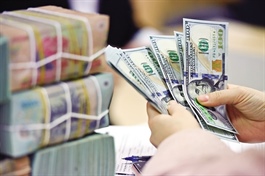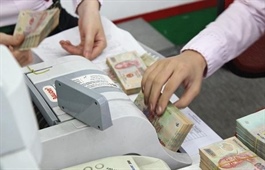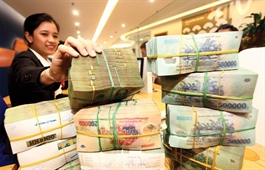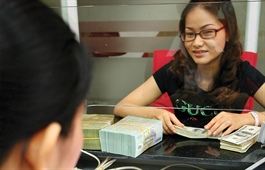Bank credit pours into the economy reaching $611 billion
Bank credit pours into the economy reaching $611 billion
Announcing performance results of the banking industry in Hà Nội, the deputy governor of the SBV said monetary policy in 2024 was reasonable, ensuring the country’s GDP growth at 7.08 per cent and inflation under control at 3.6 per cent.

View of the conference. The average deposit interest rate rose by 0.73 percentage points compared to the end of 2023, while the average lending interest rate fell by 0.59 percentage points. Photo SBV |
View of the conference. The average deposit interest rate rose by 0.73 percentage points compared to the end of 2023, while the average lending interest rate fell by 0.59 percentage points. Photo SBV
HÀ NỘI — The proportion of bank credit pouring into the economy is high, from VNĐ13.6 quadrillion (US$533 billion) by the end of 2023, to VNĐ15.6 quadrillion ($611 billion) by the end of 2024, deputy governor of the State Bank of Vietnam (SBV) Đào Minh Tú said on Tuesday in Hà Nội.
At a press conference to announce performance results of the banking industry, Tú said the SBV’s monetary policy in 2024 was reasonable, ensuring the country’s GDP growth at 7.08 per cent and inflation under control at 3.6 per cent.
Deposit and lending interest rates have still been in harmony, with the average deposit interest rate increasing by 0.73 percentage points compared to the end of 2023, while the average lending interest rate decreasing by 0.59 percentage points.
Tú noted at the end of 2024, some small commercial banks increased deposit interest rates to ensure liquidity. The SBV is still monitoring the move, but it sees the deposit rate rise as being under control, with no moves to intervene.
“Deposit interest rates are completely under control so that depositors do not have to run from one bank to another to gain higher rates,” Tú said, adding bank savings do not tend to flow into other investment channels.
Regarding the SBV’s exchange rate management, Tú said, there were times in 2024 when the VNĐ/USD exchange rate increased by more than 7 per cent, but compared to other Asian countries, Việt Nam's exchange rate was still the most stable in 2024, with the rate increasing by about 5.03 per cent on average throughout the year.
“The exchange rate last year fluctuated according to market supply and demand, but it ensured harmony and balance between exports and imports. Enterprises and investors were completely assured about Việt Nam's exchange rate,” Tú said.
At the event, Tú also referenced the SBV’s gold management last year. The difference between the price of SJC gold bars and the world price was nearly VNĐ20 million per tael at times, but it is currently only about VNĐ3-4 million per tael.
“The SBV is also considering amending Decree 24/2012/NĐ-CP, which governs the management of gold import and export activities by the SBV, to ensure the legitimate rights of the people. The SBV considers stabilising the gold market a very urgent task that requires immediate action,” Tú noted.
As for payment technology, which was a topical issue in 2024, Tú said that 84.7 million bank accounts have been so far biometrically authenticated. Cases of fraud and account appropriation have decreased by more than 50 per cent since the application of the technology.
He said the SBV in 2025 will continue to closely follow market developments and the domestic and foreign economic situation flexibly and synchronously, managing monetary policy to control inflation and stabilise the monetary and foreign exchange markets, which will in turn contribute to stabilising the macro-economy.
Credit management solutions will be implemented in line with macroeconomic developments and inflation, Tú said, noting however the banking industry will ensure the credit capital needs of the economy.
“The SBV will assign credit growth targets for 2025 to credit institutions from the beginning of the year and publicly announce the credit growth standards so that the institutions can proactively implement their credit growth,” Tú said.

























